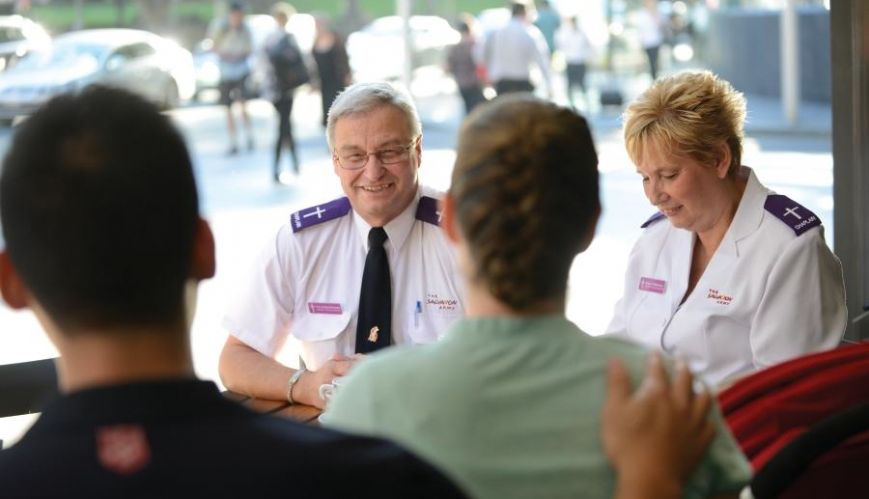Breathing life into local mission

Breathing life into local mission
14 September 2018
"We now have an opportunity to strengthen how we work together and implement a nationally consistent approach to local mission delivery where people are engaged in meaningful and holistic ways."
It’s the start of another week and the door of the local Salvos Store is swung open, ready for the public.
The chaplain has already had an early-morning coffee with someone in crisis. The social services manager is assessing how the centre ran over the weekend and the local corps officer is sitting, reflecting on how the weekend just went.
The work of The Salvation Army in Australia is diverse and high-impact. Every year, the Salvos support hundreds of thousands of Australians, with countless lives transformed with the love of Jesus.
But here’s the thing: our local expressions haven’t always been well-connected. Sometimes partnership between Salvo expressions in the same geographical area has been limited. In fact, I’ve even heard stories of Salvo expressions who share a building, but are strangers to one another.
We now have an opportunity to strengthen how we work together and implement a nationally consistent approach to local mission delivery where people are engaged in meaningful and holistic ways.
As part of the national transformation and in line with our new national strategy, a new approach to local mission is being implemented.
It’s called the Local Mission Delivery Model, and it is set to see local Salvo expressions working together like never before.
The new approach is well underway in NSW, ACT, Queensland and Victoria, with plans to roll out across the rest of the country in January 2019. .jpg&width=300&height=200)
The Local Mission Delivery Model is a restructuring of how local mission expressions engage with each other.
Representatives from Salvo expressions in a common geographical area meet every four to six weeks for networking, planning, resource sharing, strategic thinking and communication around the work of The Salvation Army in that particular region.
model in action
Picture for instance, the north-east region of Victoria. Every six weeks or so, people travel from different regions (Shepparton, Craigieburn, Wodonga, Broadford) and meet and discuss the vision and mission of The Salvation Army.
Time is spent considering what “working together” looks like in that particular context. Are there resources we could share? Is there a strategic project we could work on together?
Jo Barrett, General Manager of SalvoCare Northern, says that in the North East Victoria Area Leadership Team, communication between homelessness, drug and alcohol, and financial hardships programs and corps personnel has strengthened.
She says she is confident that this can prepare everyone to work collaboratively, identifying local needs, seeking solutions and presenting as one Salvation Army to the local community.
Not only then does the Area Leadership Team make The Salvation Army more effective in the community, it also, as Jo points out, “strengthens the internal network of The Salvation Army, statewide and nationally”.
Heading much further north, the Local Mission Delivery Model has been implemented in North Queensland. Bronwyn Vinen is the Area Manager for Salvos Stores, Townsville, and she says that the Area Leadership Team in North Queensland “is a great opportunity for all expressions to build relationships and grow in our faith journeys and is a wonderful opportunity for networking”. .jpg&width=300&height=200)
After speaking with the coordinating chaplain for Melbourne Airport, Captain Martyn Scrimshaw, I had a sense that the new Area Leadership Team meetings were both challenging and helpful. They were challenging in the sense that the uniqueness of the airport environment meant that ministry is not confined to being local. People come and go, travelling both domestically and internationally, needing referrals to all types of places, like St Kilda Crisis Centre and Melbourne 614.
The Area Leadership Teams have been helpful in regards to “getting all expressions of the Salvos together in the one room”. As Captain Scrimshaw says, it brings together like-minded people, in order that they can think about our vision, mission and values as they relate across The Salvation Army.
Major Gaye Day, the Gunnedah Corps Officer, says, “the benefit of having the Area Leadership Team is that it provides a collaboration platform for mission, resources, support and fellowship ... and this has been very beneficial in the rural setting, which often can feel isolated and under-resourced”.
effective mission
The role of an Area Officer is a fairly new concept, so it is interesting to hear the perspective of an Area Officer helping to roll out the implementation of the Local Mission Delivery Model.
Major Christine Wright (Area Officer for Metro West – Victoria Division) says, “Area Leadership Teams give all ministry expressions a deliberate, regular time to meet together and share stories from their area, which helps each expression grow in understanding and appreciation of the vast scope of engagement The Salvation Army has. This in turn has provided important opportunities to discover ‘intersection points’ where expressions can ‘value add’ to each other”.
The Local Mission Delivery Model is still in its infancy stage. That being said, early indications reveal that it is helping The Salvation Army better align its people and resources towards effective mission.
Personally, I see a bunch of immediate benefits:
· Meaningful fellowship reminds you you’re not on the journey alone;
· Effective communication means you stay up to date with what’s happening across the board;
· Working together helps us impact communities in a more holistic way;
· Sharing of resources becomes an opportunity for better overall stewardship; and
· Regular discussion about the vision and mission of The Salvation Army helps local mission expressions to stay focused on what matters most.
The Local Mission Delivery Model, with its Area Officers and Area Leadership Teams is a different way of operating, but it’s filled with potential. As Major Isabel Beckett (Area Officer – North/North West NSW) suggests, the Area Leadership Team meetings have the potential to enlarge our vision and open our eyes to the possibilities of what can be.
So pause for a moment. Soon another week will start. The Salvos Store will swing open its doors again. The emergency relief service will get ready to meet people’s needs. The chaplain will connect once again and make sure the barista is grinding the coffee. The social services manager will engage with their communities. The corps officer will get ready for another week of opportunity. And quietly, but progressively, the Local Mission Delivery Model will have had an impact.
Resourcing, encouraging and aligning what is collectively done in communities all over Australia, to transform one life at a time with the love of Jesus. For more information about the national strategy, please head to australiaone.info
Key features:
• The new model brings together geographical Areas of The Salvation Army for Local Mission Delivery (LMD)
• An Area consists of all Mission Expressions and connects these to deliver integrated, holistic Missional outcomes.
• Areas are supported by Area Officers and Area Leadership Teams (ALTs)
• ALTs bring together representative leaders of all Mission Expressions to set strategic go
Key changes:
• We will work collaboratively with all Mission Expressions in our Areas, in a consistent way, to better understand and address the needs of local communities.
• Area Officers will drive local Missional outcomes in these Areas.
• ALTs will enable a strategic focus on integrated, holistic outcomes for the benefit of the community.
• Corp Officers will report to Area Officers.
• Area Officers will report to Divisional Leaders.
Captain Peter Brookshaw is the Corps Officer of The Salvation Army Craigieburn